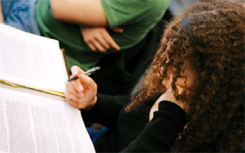Vox Populi
Close Encounters
One of the most difficult—but most worthwhile— tasks I was given at the University of Chicago was learning how to close-read, that is, to dive into a text and not emerge until I had found some deep, hidden meaning not available at first glance. At first, I really hated doing it—it seemed tedious and fruitless. Around me, classmates were unearthing insights about turn-of-the-century social class in Henry James, yet I never seemed to come up with anything valuable.
Eventually, I learned the reason: I simply wasn’t working hard enough. But as I learned how to close-read, the work involved became a form of play and a labor of love. I could apply the skill to any document or text. It was possible—and exciting— to close-read a Broadway musical, a television commercial, a T-shirt, and come out with a deeper truth that society revealed about itself.
Close reading and the critical thinking it supports aren’t supposed to be easy. They take time and effort and can be really frustrating. No one knows this better than my ninth- and tenth-grade world-history students at New Community Jewish High School in West Hills, California. They are the intended heirs of my Chicago-style reading skills. I am familiar with their struggle, which is why I have little sympathy for them.
Actually, I’m not that callous, and I do appreciate their struggle. But I feel it’s something they should have to go through, like I did—not only because it will give them a leg up when they get to college, but also, if they’re at all like me, for the pleasure and power it will eventually give them. My students are frequently daunted by the challenge close reading poses. It is not something they have ever done in their 11 or 12 years as readers. For most of them, my world-history class was the first in which they were required to scour texts and original documents for clues to the author’s intention and to imagine how the original audiences might have understood them. After handing out a document, I often see a hand extended towards my nearly illegible scratching on the whiteboard, a quizzical look on a flustered face. “I can’t find the answer in here!”
Over time my students began to anticipate my style. By the midway point of last year, they knew to expect critical-thinking questions with no single right answer, rather than multiple-choice questions, on my exams. A tenth-grade quiz on the Russian Revolution asked: Did the Russian Revolution uphold or oppose the ideals of Marxism and socialism? Explain. From a ninth-grade exam on early Islam: Is the conflict between Sunni and Shi’a Islam religious, political, both, or neither? Explain.
By that point, though, their protests were starting to sound perfunctory. Learning to think and write critically was palpably making them feel both capable and comfortable. In fact, they began to anticipate essay prompts and drove review sessions by generating and answering questions they thought might appear on the coming exam.
In truth, triumphs were few in my first year of teaching. But they were monumental when they came. I was utterly thrilled when one of my students asserted that the French Revolution might have been a bust, given that the people wound up exactly where they’d started during the Reign of Terror—they had traded one autocrat, Louis XVI, for another, Maximilien Robespierre. In another instance, during a ninth-grade exam on ancient Rome, one of my more challenging students stood up, walked up to my desk, high-fived me, and said, “Good test. It’s really making me think.”
My students’ initial stubbornness and unwillingness to make the extra effort bothered me—but made me understand how some of my Chicago professors might have once felt. Not only their probable frustration, but their dedication: for my own experience at Chicago convinces me that teaching these skills to students at a tender age will turn them into independent, analytical thinkers—and turn their exasperation at close reading into something like pleasure.
